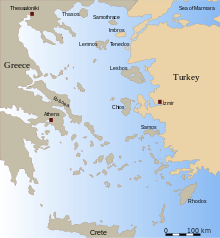Cunda Island
- This article is about Cunda Island in Turkey, for Cunda in Hinduism.
Cunda Island, also called Alibey Island, (Turkish: Cunda Adası, Alibey Adası; Greek: Μοσχονήσι or Μοσχονήσος), is the largest of the Ayvalık Islands archipelago in Turkey, which was historically called the Εκατόνησα (Hekatonisa) or Μοσχονήσια (Moschonisia) archipelago in Greek. It is a small island in the northwestern Aegean Sea, off the coast of Ayvalık in Balıkesir Province, Turkey, with an area of 23 square kilometres (9 sq mi). It is located 16 kilometres (10 miles) east of Lesbos, Greece.
Cunda Island has a typical Aegean resort town. There are frequent bus and ferry services to Cunda Island from the town center of Ayvalık. Cunda Island is connected to Lale Island, and thence to the mainland, by a bridge and causeway built in the late 1960s. This is the first and currently the oldest surviving bridge in Turkey that connects lands separated by a strait.
For some months in 1922, the island was the see of a Greek Orthodox metropolitan bishop, while the neoclassical mansion of the last metropolitan, Ambrosios, who was executed by the Turkish army, still survives on the seafront of the island's town center.[1] On September 19, 1922 several hundred of the Greek islanders were killed on Cunda during the Greek genocide, only some children were spared and sent to orphanages.[2] The next year, following the Treaty of Lausanne (1923) and the population exchange between Greece and Turkey, the few remaining islanders were forced to leave for Greece and were replaced by Cretan Turks and Turks from Lesbos. The main landmark of Cunda Island remains the Taksiarchis Church (Turkish: Taksiyarhis Kilisesi). The large, former Greek Orthodox cathedral was abandoned and dilapidated, but has now been restored.
Poroselene bay in the north of the island is among Cunda's main sights. In antiquity, it was the home of a dolphin which saved a drowning boy, mentioned by Pausanias.
In 2007, after a two-year work, all 551 buildings in Cunda Island were inspected and registered by the Turkish Science Academy and Yıldız Technical University Faculty of Architecture, as part of the "Culture of Turkey inventory project".[3]
USA-based Harvard University and Turkey's Koç University have established a joint project in Cunda Island and run a "Harvard-Koç University Intensive Ottoman & Turkish Summer School" every summer.[4][5]
Gallery
See also
References
- ↑ Charitopoulos, Evangelos. "Diocese of Moschonisia" (in Greek). Εγκυκλοπαίδεια Μείζονος Ελληνισμού, Μ. Ασία. Retrieved 14 October 2012.
- ↑ Clark, Bruce (2006). Twice a stranger : the mass expulsion that forged modern Greece and Turkey. Cambridge (Massachusetts): Harvard University Press. p. 25. ISBN 9780674023680.
On the nearby islet which is known in Greek as Moschonisi and in Turkish as Cunda, several hundred civilians of all ages were taken away and killed, only some of the children were spared and sent to orphanages
- ↑ NTV MSNBC. "Cunda evlerine nüfus kağıdı" (in Turkish). Retrieved 2009-03-31.
- ↑ "Intensive Ottoman Summer School in Turkey". Near Eastern Languages and Civilizations. Harvard Summer School 2008. Archived from the original on 2008-04-05. Retrieved 2008-04-26.
- ↑ "Department of History". Koç University. 16 July 2007. Archived from the original on 2008-10-07. Retrieved 2008-04-26.
External links
| Wikimedia Commons has media related to Cunda Island. |
Coordinates: 39°21′38″N 26°38′34″E / 39.36056°N 26.64278°E







